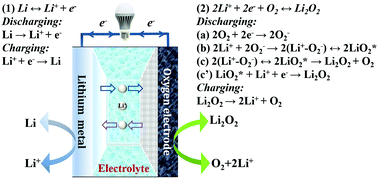当前位置:
X-MOL 学术
›
Chem. Soc. Rev.
›
论文详情
Our official English website, www.x-mol.net, welcomes your feedback! (Note: you will need to create a separate account there.)
Functional and stability orientation synthesis of materials and structures in aprotic Li–O2 batteries
Chemical Society Reviews ( IF 46.2 ) Pub Date : 2018-03-26 00:00:00 , DOI: 10.1039/c8cs00009c Peng Zhang 1, 2, 3, 4, 5 , Yong Zhao 1, 2, 3, 4, 5 , Xinbo Zhang 5, 6, 7, 8
Chemical Society Reviews ( IF 46.2 ) Pub Date : 2018-03-26 00:00:00 , DOI: 10.1039/c8cs00009c Peng Zhang 1, 2, 3, 4, 5 , Yong Zhao 1, 2, 3, 4, 5 , Xinbo Zhang 5, 6, 7, 8
Affiliation

|
The lithium–O2 battery is one of most promising energy storage and conversion devices due to its ultrahigh theoretical energy density and hence has broad application potential in electrical vehicles and stationary power systems. However, the present Li–O2 battery suffers from a series of challenges for its practical application, such as its low capacity and rate capability, poor round-trip efficiency and short cycle life. These challenges mainly arise from the sluggish and unsustainable discharge and charge reactions at lithium and oxygen electrodes, which determine the performance and durability of a battery. In this review, we first provide insights on the present understanding of the discharge/charge mechanism of such a battery and follow up with establishing a correlation between the specific materials/structures of the battery modules and their functionality/stability within the recent progress in electrodes, electrolytes and redox mediators. Considerable emphasis is paid to the importance of functional orientation design and the synthesis of materials/structures towards accelerating and sustaining the electrode reactions of Li–O2 batteries. Moreover, the future directions and perspectives of rationally constructed material and surface/interface structures, as well as their optimal combinations are proposed for enhancement of the electrode reaction rate and sustainability, and consequently for a better performance and durability of such batteries.
中文翻译:

非质子型Li–O 2电池 材料和结构的功能和稳定性取向合成
O 2锂电池由于其极高的理论能量密度而成为最有前途的能量存储和转换设备之一,因此在电动汽车和固定电源系统中具有广阔的应用潜力。然而,目前的Li–O 2电池在实际应用中面临一系列挑战,例如低容量和高倍率能力,差的往返效率和短循环寿命。这些挑战主要来自锂和氧电极的缓慢和不可持续的放电和充电反应,这决定了电池的性能和耐用性。在这篇综述中,我们首先提供对这种电池的放电/充电机理的当前了解,并在最近的电极发展过程中建立电池模块的特定材料/结构与其功能/稳定性之间的相关性。 ,电解质和氧化还原介体。2个电池。此外,提出了合理构造的材料和表面/界面结构的未来方向和观点,以及它们的最佳组合,以提高电极反应速率和可持续性,从而提高这种电池的性能和耐久性。
更新日期:2018-03-26
中文翻译:

非质子型Li–O 2电池 材料和结构的功能和稳定性取向合成
O 2锂电池由于其极高的理论能量密度而成为最有前途的能量存储和转换设备之一,因此在电动汽车和固定电源系统中具有广阔的应用潜力。然而,目前的Li–O 2电池在实际应用中面临一系列挑战,例如低容量和高倍率能力,差的往返效率和短循环寿命。这些挑战主要来自锂和氧电极的缓慢和不可持续的放电和充电反应,这决定了电池的性能和耐用性。在这篇综述中,我们首先提供对这种电池的放电/充电机理的当前了解,并在最近的电极发展过程中建立电池模块的特定材料/结构与其功能/稳定性之间的相关性。 ,电解质和氧化还原介体。2个电池。此外,提出了合理构造的材料和表面/界面结构的未来方向和观点,以及它们的最佳组合,以提高电极反应速率和可持续性,从而提高这种电池的性能和耐久性。



























 京公网安备 11010802027423号
京公网安备 11010802027423号